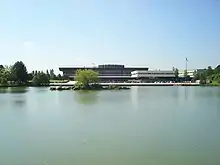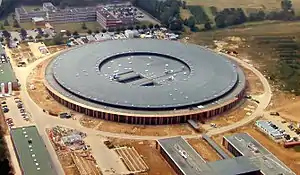Polytechnic Institute of Paris
The Polytechnic Institute of Paris (French: Institut polytechnique de Paris) is a public technological university located in Palaiseau, France. It consists of five engineering grande écoles: École Polytechnique, ENSTA Paris, ENSAE Paris, Télécom Paris and Télécom SudParis.
Institut polytechnique de Paris | |
     | |
| Type | Public research university |
|---|---|
| Established | 1741 ENSTA Paris 2019 Scission from Paris-Saclay University |
| Chancellor | Christophe Kerrero |
| President | Éric Labaye |
| Students | 8,500 |
| Postgraduates | 1,500 |
| 950 | |
| Location | , , 48.7117343°N 2.1712888°E |
| Campus | Paris-Saclay |
| Website | ip-paris.fr/en |
With the Paris-Saclay University, the Polytechnic Institute of Paris is part of the Paris-Saclay project, which is a research-intensive academic campus and business cluster being developed on the Plateau de Saclay near Paris. The project integrates several engineering schools and research centers that are part of the world's top research organizations in various fields.[1][2]
The technological university was formed around the École polytechnique, one of the most respected and selective grandes écoles in France. Among its alumni and teachers are five Nobel prize winners,[3] Two Fields Medalist,[4] three Presidents of France[5] and many CEOs of French and international companies.
History
After World War II, the rapid growth of nuclear physics and chemistry meant that research needed more and more powerful accelerators, which required large areas. The University of Paris, the École Normale Supérieure and the Collège de France looked for space in the south of Paris near Orsay. The Orsay branch of the University of Paris eventually became an independent university, called Paris Sud University. In 1976, the École polytechnique joined the region, by moving from central Paris to Palaiseau. Other institutes joined the region in the following decades, most notably ENS Cachan, Télécom Paris, and ENSTA, as part of the Paris-Saclay project, a national effort to regroup research and business activities.
In 2015, these institutes were grouped together as a university community (ComUE) called Paris-Saclay University. The goal was to be recognized as an entity of sufficient size and quality, and to become a top-ranking, research-focused French university. Each member institution would remain independent but share a significant portion of existing and newly invested resources. This follows a model similar to the one adopted by University of Oxford and Cambridge, where each constituent college keeps its independence while being grouped under a 'university'.
Confronted with disagreements between its members (engineering schools versus universities, French Ministry of Defense versus Ministry of Higher Education), the University of Paris-Sud proposed to transform itself into Paris-Saclay University in 2017, with the engineering schools being only associated to the future institution. On October 25, 2017, the French president Emmanuel Macron announced the creation of a second university pole in Paris-Saclay, which would split away from Paris-Saclay University and regroup the engineering schools. This new pole was initially called "NewUni", and became the Polytechnic Institute of Paris in February 2019.
HEC Paris also joined the new university pole without becoming a member. Other higher education or research institutions may join in the future. Paris-Saclay University and the Polytechnic Institute of Paris co-operate in several master's degrees and PhD programs[6]
On September 15, 2020, the Institute co-founded with HEC Paris[7] the artificial intelligence research center Hi! PARIS.[8][9]
Organisation
Grandes écoles
The Polytechnic Institute of Paris comprises five grandes écoles:
| Name | Foundation[10] | Field | Students | Campus |
|---|---|---|---|---|
| École polytechnique | 1794 | Science and engineering | 2,316 | Paris-Saclay, Paris |
| ENSTA Paris | 1741 | Science and engineering | 897 | Paris-Saclay |
| ENSAE Paris | 1945 | Science and engineering | 581 | Paris-Saclay |
| Télécom Paris | 1878 | Science and engineering | 1,360 | Paris-Saclay |
| Télécom SudParis | 1979 | Science and engineering | 822 | Évry-Courcouronnes, Paris-Saclay |
 École polytechnique, seen from the lake
École polytechnique, seen from the lake Side court of the building of Telecom Paris and Telecom SudParis
Side court of the building of Telecom Paris and Telecom SudParis Main court of the building of Telecom Paris and Telecom SudParis
Main court of the building of Telecom Paris and Telecom SudParis ENSAE Paris
ENSAE Paris ENSAE Paris seen from the South
ENSAE Paris seen from the South ENSTA Paris
ENSTA Paris
Research organizations
The following research organizations have established research centers within the Polytechnic Institute of Paris. The resources contributed by these organizations will remain largely independent from other member institutions.
- CEA (Atomic Energy and Alternative Energies Commission)
- CNRS (French National Centre for Scientific Research)
- Inria (French Institute for Research in Computer Science and Automation)
- INSERM (French Institute of Health and Medical Research)
- Institut des Hautes Études Scientifiques (Institute of Advanced Scientific Studies)
- INRA (French National Institute for Agricultural Sciences)
- ONERA (National Board of Study and Aerospace Research)
- SOLEIL (national synchrotron facility)
University rankings
| University rankings | |
|---|---|
| Global – Overall | |
| ARWU World[11] | 301-400 (2022) |
| CWUR World[12] | 43 (2022-2023) |
| QS World[13] | 38 (2024) |
| THE World[14] | 95 (2023) |
In international rankings, the Polytechnic Institute of France is ranked 38th overall and 12th in graduate employability by QS World University Rankings.[15] It is ranked 71th by Times Higher Education,[16] 301-400 by the Shanghai Ranking,[17] and 41st in the world by the CWUR Ranking.[18]
References
- Staley, Oliver (13 March 2014). "Nations Chasing Harvard Merge Colleges to Ascend Rankings". bloomberg.com. Retrieved 13 March 2014.
- Nic Mitchell "Big is beautiful for merging universities",BBC News,25 November 2015
- Becquerel, Allais and Tirole.
- Jean-Christophe Yoccoz (1994) ; Yoccoz was not a student at Polytechnique because he chose to be educated at École Normale Supérieure (1975-1979), but he completed his Ph.D. under Michael Herman in 1985 in the Centre de mathématiques Laurent Schwartz of École Polytechnique, a research centre which had been created by another Field medalist and a professor at Polytechnique : Laurent Schwartz.
- Sadi Carnot (who was the nephew of Carnot the physicist and the grandson of Carnot the École founder), Lebrun and Giscard.
- "Institut Polytechnique de Paris officially established". www.telecom-paris.fr. Retrieved 2019-09-01.
- Hi!Paris, L’Institut Polytechnique De Paris Et HEC Paris Affichent Leur Ambition Dans L’IA
- Zoom sur Hi! PARIS, le centre consacré à l’IA et aux Sciences des données de l’Institut Polytechnique de Paris et HEC Paris
- HEC et Polytechnique lancent le centre pluridisciplinaire Hi! Paris pour devenir champions de la recherche en IA
- Foundation of the oldest constituent part of the school
- "ARWU World University Rankings 2022 | Academic Ranking of World Universities 2022 | Top 500 universities | Shanghai Ranking - 2022". www.shanghairanking.com.
- "Center for World University Rankings 2022-2023".
- "QS World University Rankings 2024".
- "World University Rankings". www.timeshighereducation.com/. 4 October 2022.
- "QS World University Rankings 2024: Institut Polytechnique de Paris". Retrieved 1 July 2023.
- "Times Higher Education World University Rankings 2023: Institut Polytechnique de Paris". 12 October 2022. Retrieved 5 July 2023.
- "2022 Academic Ranking of World Universities". Retrieved 5 July 2023.
- "Global 2000 List By The Center For World University Rankings". Retrieved 27 July 2021.



